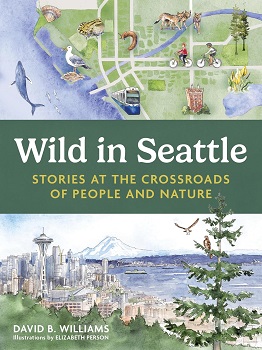Wild in Seattle: Stories at the Crossroads of People and Nature by David B. Williams
Summer is a perfect time to slow down and look deeply at the habitat around us, and “Wild in Seattle: Stories at the Crossroads of People and Nature” by David B. Williams is a brilliant invitation to do so. While the essays in this collection focus on Seattle’s urban environment, readers will find inspiration to apply the same curiosity to our Whatcom County home.
After college, Williams moved to Utah to become a park ranger where, during campfire talks, he was struck by how interested visitors were to learn about the local geology, flora and fauna. He encouraged them to bring this same curiosity back to their home ecosystems, and when he returned to Seattle about three decades ago, Williams took his own advice.
Since then, Williams has written four other books and coauthored two that explore the human and natural history of the Seattle/Puget Sound area. Through his writing, he has sought to realize his goal of becoming a naturalized inhabitant of the region, using the description of “naturalized” that Robin Wall Kimmerer cites in her bestselling book, “Braiding Sweetgrass”: “Being naturalized to a place means to live as if this is the land that feeds you, as if these are the streams from which you drink, that build your body and fill your spirit.”
The opening chapters of “Wild in Seattle” explore the vast geological imprints of time on this area, revisiting the Ice Age as well as impacts of floods, earthquakes, tsunamis, erosion and attempts to fill in tideflats to increase buildable land. Williams recently hiked Oyster Dome trail (located near Blanchard Mountain just south of Bellingham) with his wife and describes standing on the top, imagining the area under 5,000 feet of ice, which is the thickness geologists have determined covered this area during the Ice Age.
Williams next turns his curiosity to the fauna of the area, devoting chapters to the likes of coyotes, otters, crows, pigeons and extinct Coast Salish woolly dogs. Among the fascinating facts gleaned from these chapters, I learned about an unusual group of kokanee salmon (kokanee means “red fish” in the Sinixt Interior Salish language) that return each year to Lake Sammamish. Fun fact: Because these fish were isolated during the last Ice Age from the Lake Washington kokanee, the Lake Sammamish kokanee evolved into a genetically distinct population.
Other tales of fauna might give you nightmares, like the shipworms (bivalve teredo clams and other marine borers called gribbles) that bore into dock pilings, often resulting in infrastructure failure. Or details about the at least 29 species of slugs that occur in Washington state, including seven species of jumping slugs!
The final chapters explore the “green seduction” of our flora and habitat, with chapters dedicated to horsetail, devil’s club, and other plants we know and sometimes love. Devil’s club, reviled by bushwhackers trying to navigate through its tall prickly spines, has been incredibly useful to Indigenous peoples throughout history and into the present, who have used decoctions of the plant for pain relief, diabetes and skin disorders, to name just a few of the many uses.
Thich Nhat Hanh said, “The most precious gift we can offer anyone is our attention.” Williams’ love for the Puget Sound area is evident in the careful attention he lavishes on each of his subjects, and watercolor illustrations by Everett illustrator Elizabeth Person bring a sense of discovery to each page.
Let “Wild in Seattle” entice you to slow down, observe and reconnect with the natural world around you — and may you find a deepened appreciation for this ecosystem that supports us and the lives with whom we share it.
Lisa Gresham is the collection services manager for the Whatcom County Library System, wcls.org.
(Originally published in Cascadia Daily News, Monday, July 21, 2025.)

